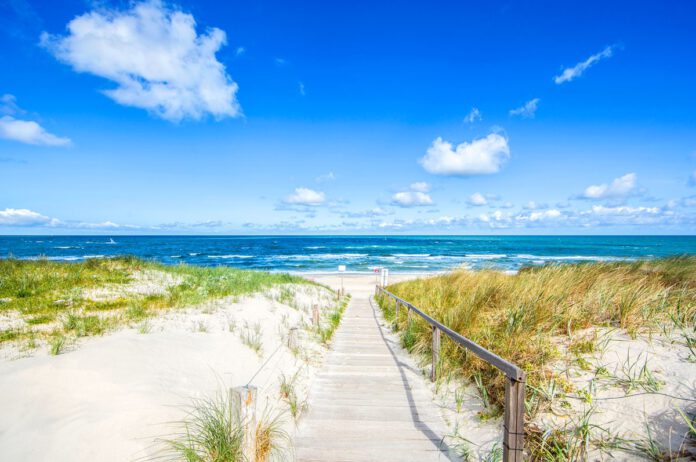The Darß Peninsula on the Baltic Sea — it offers beaches and sunbathing, but above all impressive cliffs, a resting place for tens of thousands of cranes in autumn, and home to one of the oldest artists’ colonies in Germany.
The West Beach is a wild idyll. Every wave changes the sandy coast, and the wind usually blows strongly here. Pines from the Darß forest lie across the beach because the stormy sea has washed the ground from under their roots. Other conifer trees have been shaped by nature; the constant breeze from the water has pushed their crowns towards the land, hence they are called “wind throwers.” The coast between Ahrenshoop and the lighthouse “Darßer Ort” is as rugged as it is romantic.
Souvenirs of holidays are found in the splash water stripes here: the salty water deposits fossilized sea urchins and thunderbolts, remnants of squid from the Cretaceous period.
When there is fireplace weather in autumn, onshore wind and wave crests stir up the seabed, excursionists can already look forward to the next day. Because after the storm, when the sea calms down again and the sky shines again, sometimes a piece of amber falls out of the washed-up clumps of seaweed when lifted and shaken, although usually only a small splinter. A self-found amber is probably the best souvenir.
The Darß is less about strolling and promenading, but rather an idyll for those who like to feel sand on their faces and love sturdy shoes for extensive beach walks.
For kilometers, there are no kiosks, no kite surfing schools, and no clothing stores. The island leaves the artificial to the artists who make the coastal strip by the sea and lagoon a special place, especially in the off-season.
You can wander across the peninsula wonderfully, still in sturdy shoes if you wish. From Fischland, as the narrow land bridge is called at the beginning, all the way to Zingst, the eastern outpost, numerous galleries and studios exhibit drawings, etchings, and oil paintings mainly by the artists who once came to the peninsula and discovered their painting paradise here. In many places, little has changed on the Darß since then, and the painter Paul Müller-Kampf, one of the founders of the Ahrenshoop artists’ colony, could still, as he did in 1889, note, “the dunes crowned with ancient hawthorn trees, holly, and wild roses. That was a study place as I had always wished for.”
Every year, two auctions attract art enthusiasts with paintings created on the Darß or by painters who stayed there — in summer in Ahrenshoop and on New Year’s Day in Wieck am Bodden.
Other lines draw the flying artists who give their performance with their flight formations in autumn. Cranes from Northern and Eastern Europe also rest on the eastern tongues of the Darß on their way south.
The stroll through the artistic landscape is far from over. In all the villages, the traditional doors shine with motifs that sailors once brought from afar and which local carpenters now transfer to the doors. They carved arrowheads to ward off lightning, laurel branches for glory and honor, and always the inevitable sun, as fire protection, fire blessing, and radiant sky compass for ship navigation.

1. Piers
If you want to walk on water, this is the place to be. They used to be landing stages for ferries, but now they are mainly promenades. The current piers were built in the early 1990s and extend far out into the sea, nearly 400 meters in Prerow and Wustrow, slightly shorter in Zingst.

2. Zeesen Boats
The traditional boats with red sails used to be fishing boats that fished with the “Zeese,” a sack-like net. Today, you can be ferried across the lagoon with these boats, starting from the Althagen harbor near Ahrenshoop.
3. Prerow Church
The oldest church on the Darß, formerly served as a landmark for ships. The special feature: ship models hang from the ceiling, so-called votive ships, as thanks for rescue at sea.
4. Ahrenshoop Church
A very unusual, modern church, inaugurated in the early 1950s. The architect had the church built resembling a ship lying upside down, using local woods and thatch inside equipped with works by an artist from the peninsula.

5. Crane Watching
The best place to observe them is from Pramort, the easternmost part of Zingst, a location in the core zone of the National Park and therefore only
